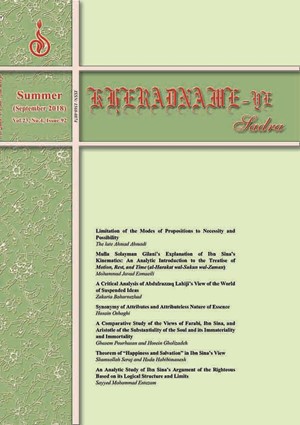Limitation of the Modes of Propositions to Necessity and Possibility
Subject Areas :
1 - University of Tehran
Abstract :
One of the accurate and profound discussions in logic pertains to the problem of modality in propositions. In the common books of logic, the definition of modality begins with the concepts of necessity, possibility, and impossibility and is later extended to perpetuity, eternity, activity, and temporality. Some logicians have referred to a maximum of 28 modes. Nevertheless, Kant maintains that the modes of propositions are only limited to possibility and impossibility, existence (actuality or in actuality) and non-existence, and necessity and contingency. In this paper, given the author’s epistemological stance, he argues that the modes of propositions are merely limited to necessity and possibility. This is because a proposition is either affirmative, with a necessity mode, or negative, again with a necessity mode. The former is called a “necessary proposition” and the latter an “impossible proposition”. In fact, it is the structures of affirmation and negation which are different from each other; otherwise, both share the same necessity mode. The mode of possibility is also related to the mind’s hesitation regarding the quality of the relationship between the predicate and the subject. If enough care is not exercised in extracting the predicate from the subject, or if the product of this process is manipulated, possibility will arise.
احمدي، احمد، بن لايههاي شناخت، تهران، سمت، 1388.
رازي، قطبالدين، شرح المطالع في المنطق، قم، انتشارات كتبي نجفي، بيتا.
سبزواري، ملاهادي، شرح المنظومه، مقدمه و تحقيق مسعود طالبي، تهران، نشر ناب، 1416 ق.
مظفر، محمدرضا، المنطق، مصحح علي شيرواني، قم، دارالعلم، 1382.
Kant, Immanuel, Critique of Pure Reason, Translate by Norman kemp Smith, Macmillan, 1929.


